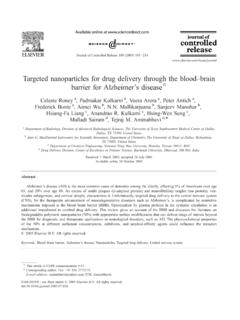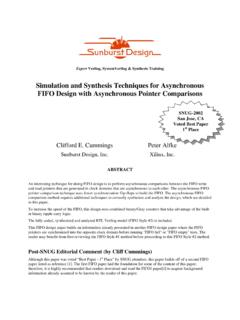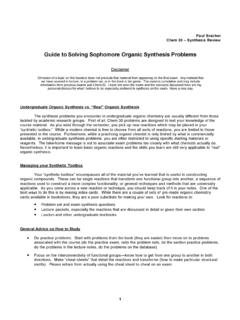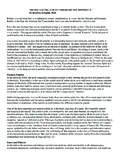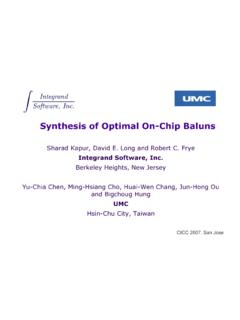Transcription of Polyaniline Nanofiber Synthesis by Co-Use of Ammonium ...
1 Polyaniline Nanofiber Synthesis by Co-Use of AmmoniumPeroxydisulfate and Sodium HypochloriteAbdelaziz Rahy, Mohamed Sakrout, Sanjeev Manohar, Sung June Cho, John Ferraris, and D. J. Yang*, Department of Chemistry & the Alan G. MacDiarmid NanoTech Institute, The UniVersity of Texas atDallas, Richardson, Texas 75080, Center for Green Chemistry, Department of Chemical Engineering,UniVersity of Massachusetts Lowell, Lowell, Massachusetts 01854, and Department of Applied ChemicalEngineering, Chonnam National UniVersity, Kwang-Ju, KoreaReceiVed December 24, 2007. ReVised Manuscript ReceiVed January 30, 2008 The polymerization to Polyaniline nanofibers was carried out in an aqueous system using aniline, 1 MHCl. and Ammonium peroxydisulfate (APS) with additional use of sodium hypochlorite solution as aco-oxidant. The addition of sodium hypochlorite solution was made either before or after the addition ofAPS.
2 This new method always produces Polyaniline nanofibers with long length. Additional advantagesof this new method are discussed. The effect of aniline concentration, hypochlorite concentration, differentacid use, reaction temperature, and both aniline and hypochlorite purity on morphology and electricalproperty of the nanofibers synthesized by this new method was IntroductionConductive polymers, such as polyacetylene and poly-aniline, have been the subject of numerous investigations inthe past two the electrically conductingpolymers, Polyaniline (Pani) has attracted intense attentiondue to its environmental stability, ease of Synthesis , excitingelectrochemical, optical, and electrical ,3 Nanofi-bers of Polyaniline have attracted even more interest becauseof their properties that make them possibly suitable forapplications as sensors,4 6batteries,7,8molecular electronicdevices, corrosion inhibitors9,10and separation ,12 Polyaniline may be synthesized by either electrochemical orchemical oxidative techniques13and can be doped to a highlyconducting state by protonic acids.
3 In recent years, consider-able efforts have been made to find specific synthesisconditions and methods for the Synthesis of polyanilinenanofibers. There are several reports by the use of hardtemplates,14soft templates,15seeding,16interfacial poly-merization,17and , David et nanofibers of semiconducting and metallicpolyaniline nanofibers. Li et the Synthesis ofpolyaniline nanofibers by conducting the conventional po-lymerization reaction at an elevated temperature withoutmechanical agitation, and Jing et al. synthesized polyanilinenanofibers by dropwise addition of a solution of ammoniumperoxydisulfate (APS, (NH4)2S2O8) into an aqueous anilinesolution in the presence of the ultrasonic described above, Synthesis of Polyaniline nanofibersrequires specific conditions. We report here that our new* Corresponding author.
4 Tel.: 1 972 883 6681. Fax: 1 972 883 2925. The University of Texas at Dallas. University of Massachusetts Lowell. Chonnam National University.(1) Chandrasekhar, Polymers, Fundamentals and Applica-tions: A Practical Approach; Kluwer Academic Publishers: Boston, (2) (a) MacDiarmid, A. Chem. Int. ,40, 2581. (b)MacDiarmid, A. ,84, 27.(3) MacDiarmid, A. G. Chiang, J. C. Richter, A. F. Somasiri, N. L. , A. J.; Alacer, L., Polymers; D. ReidelPublications: Dordrecht, The Netherlands, 1987; pp 105 120.(4) Janata, J.; Josowicz, ,2, 19.(5) Huang, J. X.; Virji, S.; Weiller, B. H.; Kaner, R. Am. ,125, 314 315.(6) Virji, S.; Fowler, J. D.; Baker, C. O.; Huang, J.; Kaner, R. B.; Weiller,B. ,1(N 6), 624 627.(7) MacDiarmid, A. G.; Somasiri, N. L. D.; Mu, S. L.; Wu, W. Q.; Chiang,J. C.; Huang, W. S.
5 ; Halpern, M. Electrochem. ,131,C328.(8) MacDiarmid, A. G.; Yang, L. S.; Huang, W. S.; Humphery, B. Met.,1987,18, 393.(9) Deberry, D. Electrochem. ,132, 1022.(10) Mengoli, G.; Musiani, M. M.; Pelli, B.; Vecchi, Appl. ,28, 1125.(11) Anderson, M. R.; Mattes, B. R.; Reiss, H.; Kaner, R. ,252, 1412.(12) Kaner, R. ,125, 65.(13) Huang, W. S.; Humphrey, B. D.; G MacDiarmid, Chem. Soc.,Faraday ,82, 2385.(14) (a) Martin, C. Chem. ,28, 61. (b) Martin, C. ,8, 1739.(15) Qiu, H.; Wan, M.; Matthews, B.; Dai, ,34,675.(16) (a) Zhang, X.; Goux, W. J.; Manohar, S. Am. Chem. ,126, 4502 4503. (b) Xing, S.; Zhao, C.; Jing, S.; Wang, ,47, 2305 2313.(17) (a) Huang, J.; Kaner, R. Chem., Int. ,43, 5817 5821. (b) Huang, J.; Kaner, R. Am. Chem. ,126, 851.(c) Huang, J.; Virji, S.; Weiller, B. H.; Kaner, R.
6 Am. ,125, 314. (d) Zhang, X.; King, R. C. Y.; Jose, A.; Manohar,S. ,145, 23 29.(18) (a) Pinto, N. J.; T Johnson, A., Jr.; MacDiarmid, A. G.; Mueller, C. H.;Theofylaktos, N.; Robinson, D. C.; Miranda, F. Phys. ,83, 4244. (b) Zhou, Y.; Freitag, M.; Hone, J.; Staii, C.; Johnson,A. T., Jr.; Pinto, N. J.; MacDiarmid, A. Phys. ,83,3800.(19) Sarno, D. M.; Manohar, S. K.; MacDiarmid, A. ,148, 237 243.(20) Chiou, N. R.; Epstein, A. Met.,2005,153, 69 72.(21) Li, D.; Kaner, R. Am. Chem. ,128, 968 975.(22) Jing, X.; Wang, Y.; Wu, D.; Qiang, ,14, 75 ,20,4808 CCC: $ 2008 American Chemical SocietyPublished on Web 07/17/2008robust method, comprising the addition of sodium hypochlo-rite before of after APS addition, always produces nanofibersat wide ranges of aniline concentrations and that of temper-ature (0 30 C). Polyaniline nanofibers produced by this newmethod are several micrometers in length with less than 40nm diameter with narrower molecular weight distributionscompared to the Synthesis done with APS Experimental (Aldrich, ACROS) was either used asreceived or distilled and stored in a refrigerator prior to peroxydisulfate (APS, ACROS), sodium hypochlorite14% (VWR), and hydrochloric acid were used without Synthesis of Polyaniline a typical Synthesis , mL of aniline was dissolved in 100 mL of 1 M hydrochloricacid while g of Ammonium peroxydisulfate (APS) was dissolvedin 100 mL of 1 M hydrochloric acid.
7 Twenty milliliters of APSsolution was added quickly to the aniline mixture and mixed. Thisgives aniline to APS molar ratio of 1 The reaction vessel wasmaintained either at ice bath temperature (0 to 5 C) or roomtemperature. Once the reaction starts, 2 mL of an aqueous sodiumhypochlorite (5% by wt) solution was quickly added dropwise withagitation after which the stirring was stopped. The reaction vesselwas then left standing without mixing for 25 min. The thickprecipitated polymer was filtered, washed with 1 M HCl, DI water,and then acetone, followed by drying in an oven 80 C Instrumental Analysis and Electri-cal ConductiVity standard four-probe techniqueusing a Keithley 2000 instrument was employed to measure theelectrical conductivity of compressed pellets of each UV Visible Spectroscopy (UV Vis).
8 All UV vis absorbancespectra were measured on a Shimadzu UV vis 1601PC spectrometeron solutions of g of EB dissolved in 20 mL of NMP emeraldine salt, initially green in color, changes to blue uponwashing with 5% Ammonium hydroxide, indicating that thepolyaniline salt was deprotonated to the emeraldine base (EB) Gel-Permeation Perkin-Elmer series200 GPC comprising an autosampler, pump, column oven, andrefractive index detector, and NMP/LiBF4( LiBF4)asthemobile phase was used. Two different columns were used, one forlow and medium molecular weight Polyaniline (column range 2 100K), and the other for high molecular weight Polyaniline (columnrange 10 1000 K). The instrument was calibrated using narrowmolecular weight distribution polystyrene standards and the polya-niline number and weight average molecular weights and resultingPDIs are relative to these Electron morphology of each sample wasdetermined by using a Zeiss-LEO model 1530 variable-pressurefield-effect scanning electron microscope and the dried sample forSEM was prepared by coating each sample on carbon and DiscussionIn order to find the optimal conditions for the synthesisof Polyaniline nanofibers using our new method, we firstinvestigated the influence of reaction temperature.
9 When thereaction was carried out at ice bath temperatures, fibersapproximately 39 nm in diameter and 2 m in length wereproduced. However, when the reaction was conducted atroom temperature, fibers of approximately the same diameter(37 nm) but only half the lengths (1 m) were obtained, asshown in Figure 1. We also investigated the effect of anilineconcentration on the morphology of the polymerizationproduct, and found that as aniline concentration increases,the diameter of nanofibers also increases from ( 35 nm , 39 nm with M aniline to 47 nm M aniline) as shown in Figure 2. Thus, a low concentra-tion of aniline is favorable for the Synthesis of small diameterFigure of Polyaniline obtained in different temperatures. (A) Control at room temperature. (B) Using NaOCl at room temperature. (C) Control inice bath. (D) Using NaOCl in ice Mater.
10 , Vol. 20, No. 15, 2008 Polyaniline Nanofiber Synthesisfibers and, furthermore, the diameter of the fibers could bedirectly controlled by the appropriate selection of anilineconcentration. These results are consistent with a recentreport of Polyaniline nanofibers Synthesis via the 3shows the SEMs of Polyaniline samplesobtained from both the rapid and dropwise addition of observe that in both cases, Polyaniline nanofibers wereobtained. This result shows that our Synthesis method is veryrobust compared to the several different methods 22 The concentration of HCl ( and M) wasalso important since at the lower acid concentration, nonanofibers were formed. The effect of sodium hypochloriteconcentration was studied as shown in Figure 4. When thehypochlorite concentration was increased from 1, 5 to 10%, Polyaniline nanofibers were obtained.
